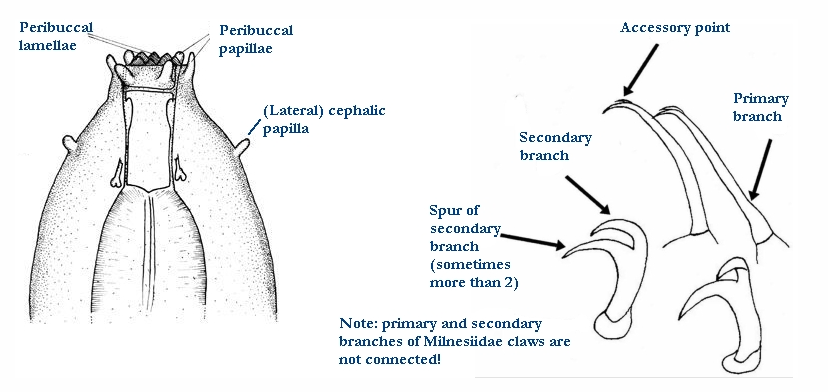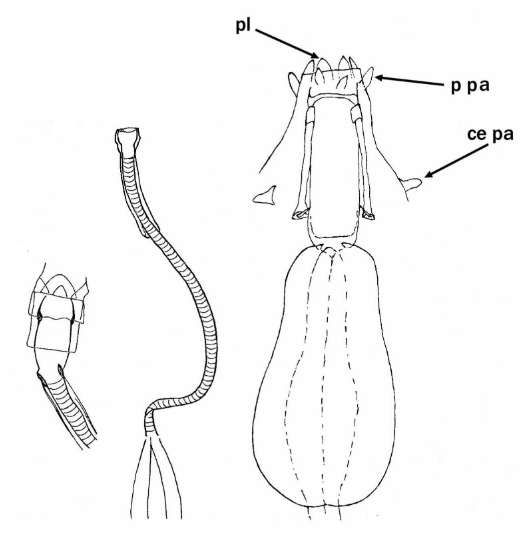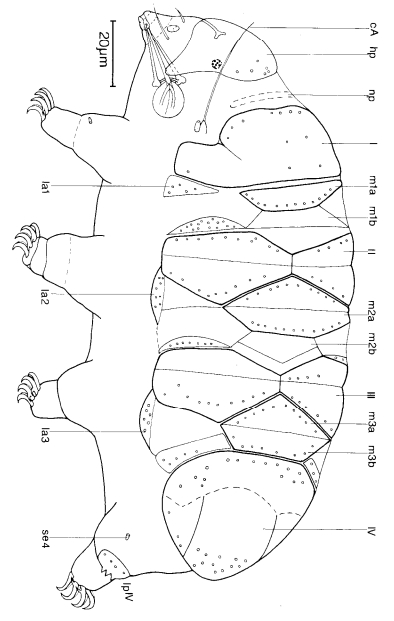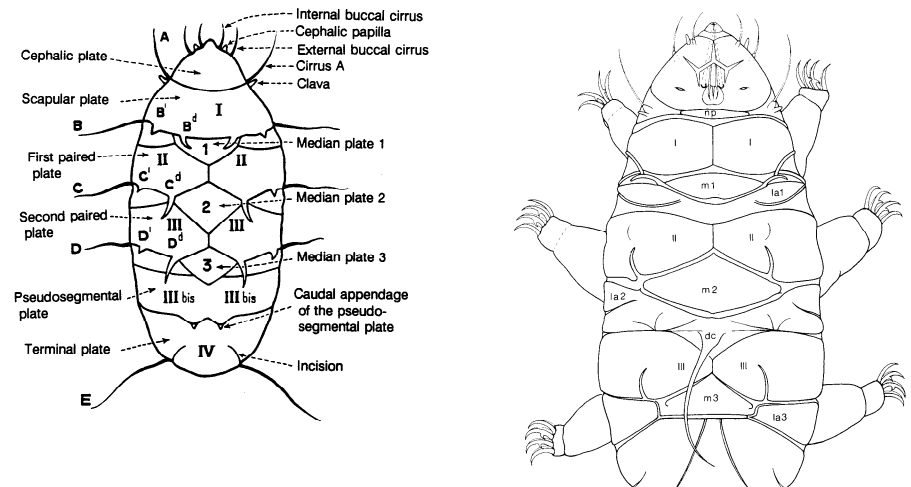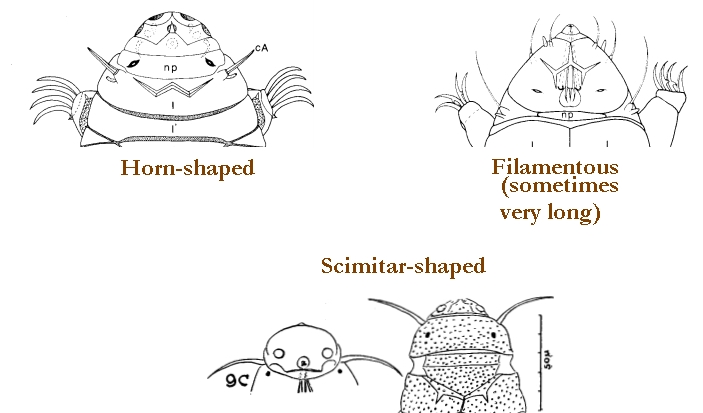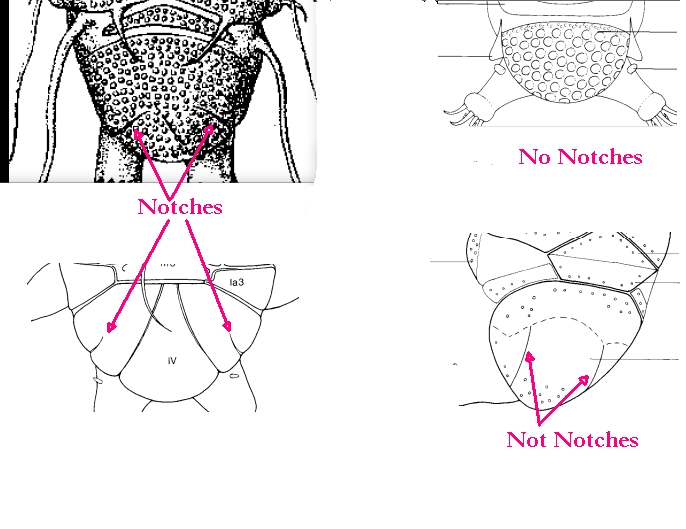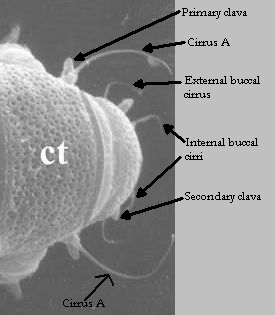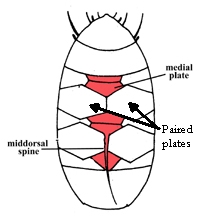Subfamily Itaquasconinae
Hypsibioidea from Pilato 1969 in Marley et al. 2011: “Parachela; claws asymmetrical (2121); Hypsibius-type claw pairs; AISM hooked (or, if the buccal tube is elongated, AISM can be broad ridges).”
Hypsibioidea from Bertolani et al. 2014: “Double claws asymmetrical with respect to the median plane of the leg (2121), the external (or posterior) claw often with flexible main branch; double claws different in size and shape on the same leg (Hypsibius and Ramazzottius type, or modified), or very reduced in size (Calohypsibius and Microhypsibius type); buccal tube often very narrow”
Hypsibioidea from Gąsiorek et al. 2018: “Eutardigrades with asymmetrical claws (2-1-2-1) and pseudolunulae at claw bases or without any cuticular structures under the basal parts. Hooked or broad-ridged apophyses for the insertion of the stylet muscles. Herbivorous or microbivorous (Guidetti et al. 2012).”
Hypsibiidae from Pilato 1969: “Senza alcuna appendice cefalica. Le due diplounghie di ciascuna zampa sono disposte asimmetricamente rispetto al piano mediano della zampa stessa e posssono essere di tipo Isohypsibius o di tipo Hypsibius. In ogni zampa le due diplounghie sono talvolta quasi uguali fra loro ma molto spesso profondamente diverse per forma e dimensioni. Lunule più spesso assenti, presenti in poche specie. L’apparato boccale è generalmente di tipo Hypsibius o Diphascon e soltanto nel genere Doryphoribius è di tipo Macrobiotus. Il bulbo faringeo è generalmente provvisto di placoidi, ne è soltanto nel genere Itaquascon.”
Translated: Without any cephalic appendages. The two double-claws of each leg are arranged asymmetrically with respect to the median plane of the leg itself and can be of the Isohypsibius or Hypsibius type. In each paw the two double-claws are sometimes almost equal to each other but very often very different in shape and size. Lunule more often absent, present in few species. The buccal apparatus is generally of the Hypsibius or Diphascon type and only in the genus Doryphoribius is of the Macrobiotus type. The pharyngeal bulb is generally provided with placoids, except in the genus Itaquascon.
Hypsibiidae from Bertolani et al. 2014: “Double claws different in shape and size on the same leg, the external (or posterior) of Hypsibius type claw with the secondary branch forming a continuous hook with its basal tract and the primary branch connected to the basal tract with a flexible part. Septulum present in the pharynx of some genera. Eggs smooth (but rarely weakly ornamented) laid within the exuvium, in some cases eggs ornamented laid free.”
Hypsibiidae from Gąsiorek et al. 2018: “Eutardigrades without cephalic papillae (sensu structures present e.g. in Halobiotus Kristensen, 1982; see Møbjerg et al. 2007) and elliptical organs. Claws of the Hypsibius type, i.e. asymmetrical both with respect to the sequence of primary and secondary branches (2-1-2-1) and with respect to the size, with external and posterior claws being always clearly larger than internal and anterior claws. Accessory points symmetrical. Two types of bucco-pharyngeal apparatuses: with the buccal tube rigid over its entire length (Hypsibiinae) or with a rigid anterior buccal tube followed by a flexible posterior pharyngeal tube (all remaining subfamilies).”
Itaquasconinae from Pilato 1969: “Unghie di tipo Hypsibius; apparato boccale di tipo Diphascon; placoidi presenti o assenti.”
Translated: Claws of Hypsibius type; buccal apparatus of Diphascon type; placoids present or absent.
Itaquasconinae from Bertolani et al. 2014: “Buccal tube followed by a flexible portion, without cuticular thickening between them; the flexible portion is an annulated pharyngeal tube in all genera (Parascon excluded); pharyngeal bulb very elongated; placoids very long and in line, sometime reduced to a bulbar lining.”
Genus description NONE YET, need Guil et al. paper! From the abstract: “The new genus is distinguished from other Itaquasconinae genera, to which it is phylogenetically related, by having a Parascon buccopharyngeal apparatus and Ramajendas claws.”
Citations :
Sarascon paper by Guil et al. goes here!
“Parts” images from Pilato G, Binda MG. 2010. Definition of families, subfamilies, genera, and subgenera of the Eutardigrada, and keys to their identification. Zootaxa. 2404: 1-54.
Bertolani R, Guidetti R, Marchioro T, Altiero T, Rebecchi L, Cesari M. 2014. Phyloeny of Eutardigrada: New molecular data and their morphological support lead to the identification of new evolutionary lineages. Molecular Phylogenetics and Evolution. 76: 110-126.
Gąsiorek P, Stec D, Morek W, Michalczyk Ł. 2018. An integrative redescription of Hypsibius dujardini (Doyère, 1840), the nominal taxon for Hypsibioidea (Tardigrada: Eutardigrada). Zootaxa. 4415 (1): 45-75.
Marley NJ, McInnes SJ, Sands CJ. 2011. Phylum Tardigrada: A re-evaluation of the Parachela. Zootaxa. 2819: 51-64.
Pilato G. 1969. Schema per una nuova sistemazione delle famiglie e dei generi degli Eutardigrada. Bollettino delle Sedute della Accademia Gioenia di Scienze Naturali in Catania, Series IV. 10 (277): 181-193.





